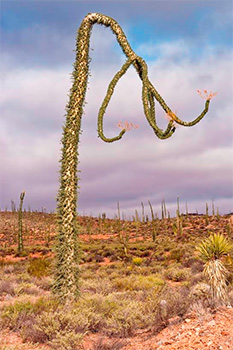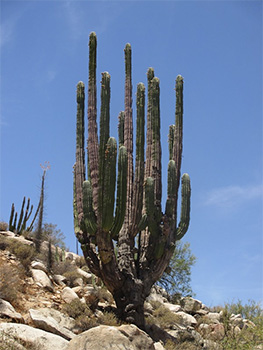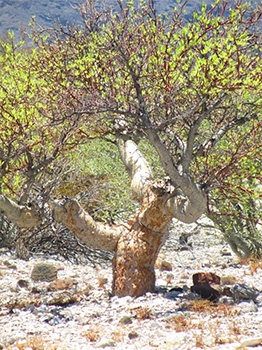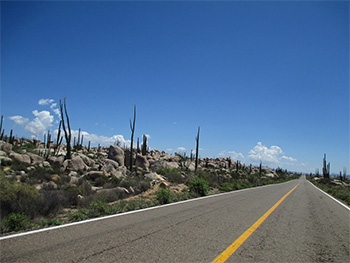 |  |

“You are not going to believe this!” my sister hollered over the roar of the VW engine. “You're going to see something that you have never seen, no one has seen these creatures unless they have driven past El Rosario! This is where the real magic of Baja begins!”
Leaving the fertile valley, I down-shifted gear to take the series of mountains heading towards Cataviña and into the magical Valley of the Cirios; a protected wild land of fanciful plant life. Gaining the summit of one hill and sliding down the other side, the boojum appeared. I exclaimed, “Oh! Look! They're like Dr. Seuss characters!” Their appearance was much like the Sneetches found in the fable, heavy in the bottom, very tall, arms with odd poses and a small pointy head sometimes sporting a yellow flowered hat. The boojum shared the desert in this area with the shy elephant tree and the ten-ton cardón cactus. Alisabeth introduced me to this country over twenty years ago. Since that first trip with her and to this very day, I am amazed by this extraordinary world of Baja California.
The Central Gulf Coast region runs from Bahía de Los Angeles to the Bahía La Paz. Plants found here
have gigantic fleshy trunks and stems like the elephant tree and the elephant cactus, also known as
the cardón. The boojum also fits in this category with it white smooth skin that appears naked unless
it rains. The plant is most creature like, each has a character all of its own. It is also called a cirio as
the Spaniards thought it looked like a tapered candle. However, it is frequently bent as if bowing, or
leaning into its neighbors with friendly body language. The twisting arms will have clusters of yellow
 blossom July into September. The boojum is the elder of Baja California with a recorded 360 years. It
is also one of the tallest plants, gaining a few inches per year to attain its 60 plus feet. On the leathery
white bark there are many pencil like branches and within 72 hours of a substantial rain, the boojum
fluffs out in deep green leaves covering the whole trunk, making it look fat and furry.
blossom July into September. The boojum is the elder of Baja California with a recorded 360 years. It
is also one of the tallest plants, gaining a few inches per year to attain its 60 plus feet. On the leathery
white bark there are many pencil like branches and within 72 hours of a substantial rain, the boojum
fluffs out in deep green leaves covering the whole trunk, making it look fat and furry.
The shy elephant tree stays hidden unless it has rained. The traveler might catch glimpses of its reddish peeling bark and thick trunk that looks like an elephant's leg. It can appear as if it is dying of drought. I remember being startled having driven a stretch of road to Guerrero Negro a number of times and seeing only what looked like barren hills in the distance. But on one trip, I drove through after a rain and the mountains were lush with a forest of green elephant trees. The torchwood family is known for it resinous sap and there are nine different elephant tree species. Torote rojo is a small spreading tree of about 24 feet tall. The distinctive curling tissue paper bark reveals a yellowish fresh layer of trunk beneath. If cut or bitten it heals itself with a flow of sap. The copal species is known for its rich fragrant smell. The sap was burned as incense comparable to frankincense and myrrh. Today you can find the hardened resin, as well as incense sticks in many stores on both sides of the border. The bark has also been used as a wash for skin infections and headaches.

With its impressive mass, the elephant cactus or cardón rises out of the desert sand to over 65 feet. It has lived 200 years or more. It can not be missed as it displays amazing survival in a dry and hostile environment. Anyone traveling here would be amiss if they didn't stop at least once to stand next to it, to touch it, to experience this rarest of living things. If you are quiet, you might feel its life-force. At its base, nearly 5 feet wide sinks and a shallow root system. A large cardón may store over a ton of water in the fleshy, pulp-like tissues. When it does rain the water runs down the baffle-like sides, channeling every precious drop to its root system. Inside the giant is an accordion-like hardwood infrastructure, allowing the entire cactus to expand and contract according to the volume of water being retained.
From late March through early June the flowers begin to open. Bats and moths take advantage of the nectar and in this way they help the pollination. The fruit then appears as a fist size globe. The birds are savvy about when the juicy red fruit is ready to eat. Its many rotund branches are nesting places for hawks and cactus wrens.
The great body of the cardón has had several important uses and one is a place  of stored water. The
native people collected the fruits and seeds as important food source. The fleshy part of the stem
ranchers use on wounds as a disinfectant and as a painkiller. The dried woody ribs were used by the
Indians to make fishing spears and it is still used today for beds, fences, corrals and home building
material. The cardón is protected within the biosphere region and stealing babies anywhere is a no no.
My sister was right, you won't believe it until you see it for yourself; these ancient creatures of the Baja.
of stored water. The
native people collected the fruits and seeds as important food source. The fleshy part of the stem
ranchers use on wounds as a disinfectant and as a painkiller. The dried woody ribs were used by the
Indians to make fishing spears and it is still used today for beds, fences, corrals and home building
material. The cardón is protected within the biosphere region and stealing babies anywhere is a no no.
My sister was right, you won't believe it until you see it for yourself; these ancient creatures of the Baja.
In loving memory of Alisabeth Dobesh, she brought me to Baja and left me here. October 10, 1957 to September 28, 2007.
Martina's email: mteomaya(at)gmail.com

Easy to buy Mexico car insurance from and good service

Fast and easy!

Baja Bound is the easiest way to set up coverage before you head into Baja. Online, 5-mins, you're...